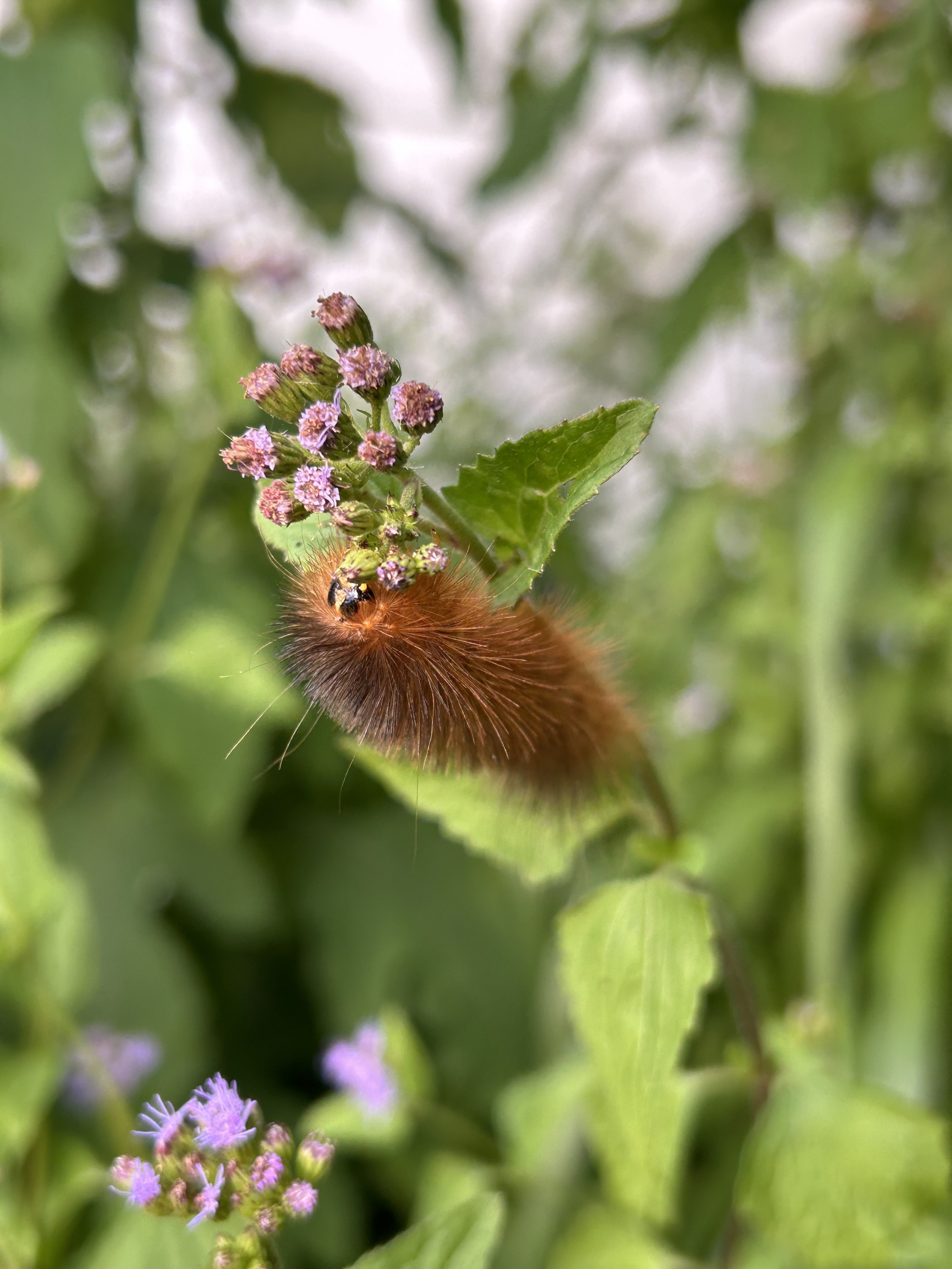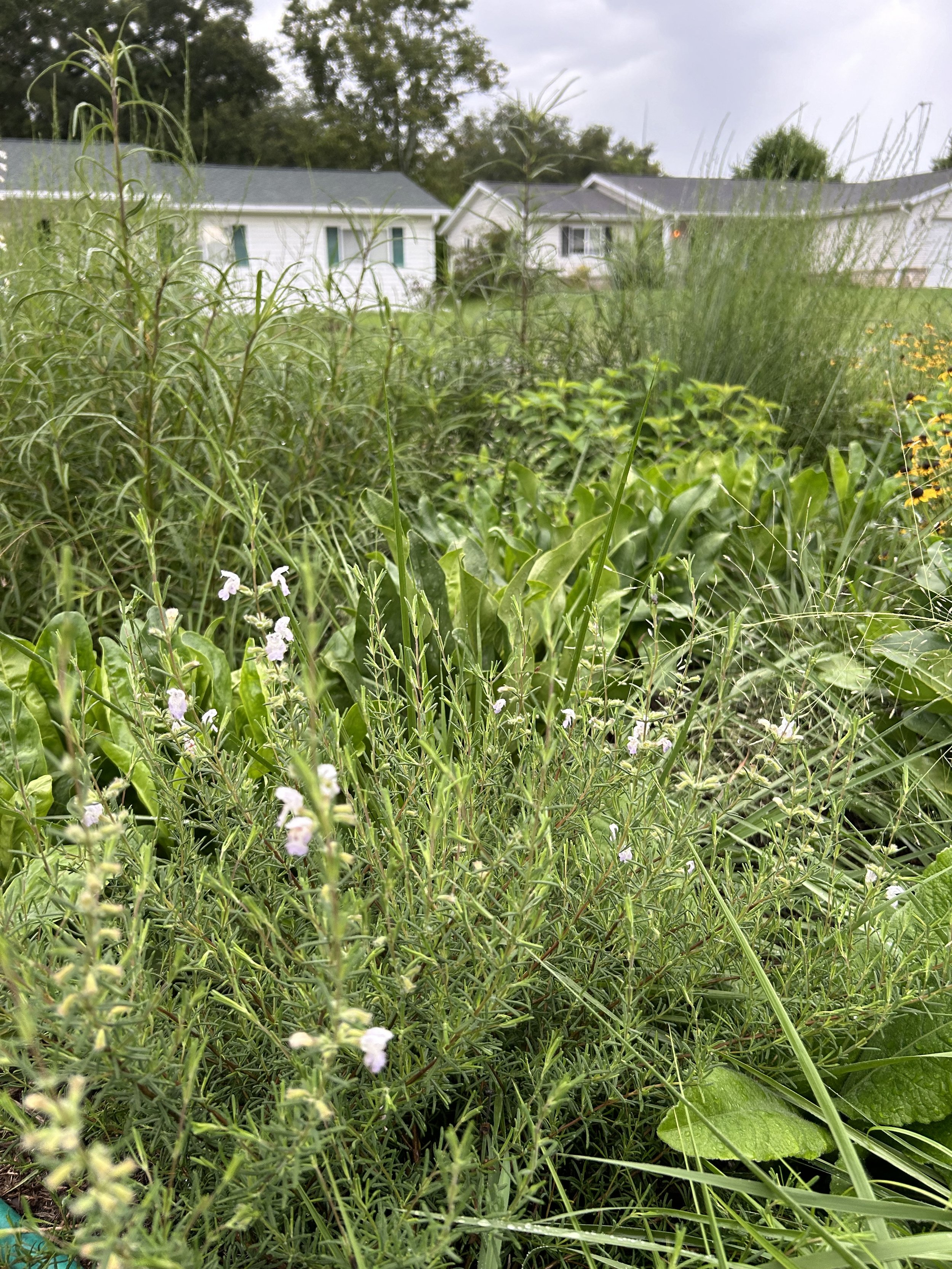Emergent Gardens’ Values
-
We need more plants. Not more mulch. Not turning lawn into hardscaping and a strip of grasses on the side. Just more plants.
We need more plants to sequester carbon from the atmosphere and lock it underground. More plant roots to build soil, break up compaction, and filter runoff. More plants for our disappearing pollinators and homes for wildlife.
Look at a 100 square feet in a natural environment. Plants cover the ground. So, why in a garden would we take that same square footage plant one shrub, several perennials, and mulch the rest? We should be using a strategic mix of plant types to cover the ground and occupy as much soil as possible.
To take one more step further: we need to break the perception that more plants makes a landscape messier. Accomplishing this is going to be done with beautiful, thoughtful design and management.
-
The term native plant applies to species that are indigenous to a region pre-settlement. They are species that have been adapting to their geographic conditions for thousands up to millions of years. In just the last few hundred years, these native plants' homes have seen incredible change. Change that has caused entire species to become lost and endangered. Change that has led to wildlife losing their food and ability to build shelter. Although unfortunately, we fortunately have learned the importance of such plants, their varied purposes, the value in preserving them, and many's superior abilities to persist in spite of great change.
The collected knowledge of native plants has proven to be hugely beneficial to designing green spaces. Using native plants in sites with conditions they have adapted to translates into cost-savings, resiliency through change, and aid for fractured plant and wildlife communities. We know that it's working. Places are seeing long-gone pollinators return because their native host plant is now everywhere. Smartly-used native plants are more likely to persist in extreme weather. And the stewards of green spaces with native plants are seeing that fewer to zero inputs are require to sustain them.
Now let me be clear: EG is not against using plants that are non-native to Florida or ones that are exotic.*
I have a lot of love for plants that are not native to Florida, but are native to other states and regions in the U.S. For example, there are many southeastern U.S. native plants to explore and experiment with in a garden. Like anything else, the decision to use such plants should be made wisely.
Ample research and resources are available describing which exotic plants are safe to use in your region. We all have exotic plants that we love. Often times an exotic plant is exactly what you need to bring a design together. Many exotic plants offer some of the benefits that native species do. It all comes down to using these plants responsibly and thoughtfully.
*Please note that plants deemed invasive are to be avoided and should be removed.
-
Ecological principles refers to processes that occur naturally and strategies that have been found to benefit ecosystems (designed and not). By practicing these principles, a garden becomes more sustainable. It gives rather than takes.
Some of the go-to strategies include:
Skip the mulch in the long-term and use green mulch
Lean on ornamental grasses and grass-likes to stabilize soil, build soil health, suppress weeds, and provide a foundation for herbaceous flowering plants.
"Leave the leaves"
Design four seasons gardens
During the dormancy period, allow stems, foliage, and seed heads to remain and cut back in late winter/early spring.
Design with a mixture of plant morphologies, a strategy found in nature
Practice water conservation with drought-tolerant plantings, "right plant right place," rain barrels, and rain gardens.
Plant more to cool off areas and purify the air.
Use hardscaping that is permeable, from recycled materials, and adds to the garden experience
Use "keystone plants"
-
Gardens have influenced civilizations for many millennia. They are and have been sources of artistic expression. Many iconic and legendary works of art have been inspired by gardens. They act as portals to explore combinations of color, shape, and texture. They provide nourishment for all beings. And historically they are places of respite from the day-to-day. Gardens are places for communities large and small to gather and share. Gardens are places of wonder that invoke deep emotions that bind a person to the land. More than ever we need that emotional bond between person and landscape.
It's no secret that we are losing our relationship to nature at an accelerating rate via the loss of green spaces. Natural ecosystems that have evolved over millions of years have been lost to development. Almost 80% of the United States' population live in urbanized areas. These urbanized areas significantly lack "green and blue infrastructure" and landscape architects are scrambling to reverse this reality. Suburbia is characterized by lawns, an obsession rooted in a bygone era. Lawns that take and are greedy for more time and nonrenewable resources. Across the country, old agricultural land lies in wait to be developed. This land is left unmanaged to become homes to destructive invasive plants, yet is sometimes the only source of forage and home for wildlife.
We have become so detached from natural processes that people fear and kill harmless pollinators. Children believe that food from a home garden is worse than what comes from the store. And shockingly, many people see deciduous trees drop their leaves in winter and wrongly think they are dying.
We need many, many more gardens now. Large and small, but abundant. Gardens to restore the bond between people and landscape, encourage stewardship, and stimulate our uniquely human capability to imagine.
Are you ready to reverse the trend of disconnection? To bring back imagination and curiosity? We already know the benefits, so let's get to planting.
-
This is a term you will hear me use often and it's not as complicated as it sounds. Plant communities are self-organized collections of species that are unique to their geographic location. They are not stagnant and respond to changes in their environment. Head over to your nearest state park or even an abandoned lot and you will see a plant community. Nature already shows us how plants organize themselves, so let's use that in garden design and landscape management.
We say "designed plant community" because we are applying ecological principles that occur naturally to a constructed space. Picture a green space you are familiar with such as a backyard or a park. What does it look like? Are there many trees that make it woodland-like? Is there a open ground receiving full sunlight making it meadow-like? We can simply use an archetype such as a meadow and design a garden that functions like one. We plant it densely, amp it up with celebratory shows of seasonal color, use waves of flowering grasses, and make it beautiful when most plants have gone to sleep in winter. Then a space transforms into community with deliberate decision-making in regards to stylistic value and promotes active stewardship. Neat, right?
-
We are so accustomed to buying plants in large sizes because we think bigger is better. But very often the opposite is the better route. Why is this?
Plants in smaller containers are better encouraged to develop more extensive root systems that those in larger containers. This translates to higher rates of survival in the landscape.
You may be surprised by just how quickly small plants grow. Sure they may not be the size of those in a one-gallon (though they often are just in a smaller container), but they will grow fast once in the ground. Although not a hard and fast rule across the board with all plants and a client’s needs, it typically makes sense to plant smaller when you can.
Also, small plants are cheaper, much cheaper. Which means you can buy more and plant more.
-
Mulch signifies a state of being in development.
People are delighted at the sight of freshly replenished mulch when that negative space has so much potential. We can do better.
Once a new garden is planted, it makes sense to add some mulch to help plants establish. After that, buying and periodically replenishing mulch should not be a priority. How is this? By:
thoroughly preparing the site first
planting densely (one plant per one square foot)
have 50-70% of the plants be groundcovers
periodically scraping weeds off the soil surface during the establishment period
using material from cutting back as mulch (it's free!)
There are types of garden spaces that do not require mulch at all, such as those inspired by extremely dry and excessively drained environments. In these spaces, the plants might be more spaced apart as that is what they want naturally. If this type of garden is thoroughly prepped before planting, then any weeds that germinate can simply be scraped off the soil surface.
There is immediate cost-savings from not routinely buying mulch and the time saved from reapplication. From this also comes the joy of understanding how the garden works rather than treating it as an object to be spruced up.
-
First and foremost, I am an ornamental grass and grass-like evangelist. Lovegrass, Muhly, bluestems, sedges, rushes - I love them all. They read as relaxing and dreamy yet elegant. They provide the perfect backdrop to herbaceous flowering plants.
My emphasis on these types of plants is strategic as well. When designing for a space that needs great ground coverage, these plants should ideally be at least 50% of the plantings. They are often cheaper to buy in bulk, are long-lived, do wonders for soil health, their roots filter rainwater, and their foliage and crowns fight back weeds.
-
These types of gardens evoke that of what we see in nature with intentional design that visually makes sense. There is more order and amplification in regards to color, texture, and pattern.
Naturalistic gardens are almost always four seasons gardens. This means that a garden is designed with how it will look week to week, month to month. A four seasons garden is the answer to having a space be beautiful in the winter to continue providing visual interest. These types of gardens are also a huge benefit to wildlife that feed on seeds, build habitat in stems and fallen leaves, and much more.
-
How you prepare a site will inform the success of your plantings. There is not a one-size-fits-all approach to site preparation because it depends on the design, budget, timeline, and how much work you are willing to put into it.
EG assesses what is present in a landscape and the goals to decide on what are the best site preparation methods to employ.


